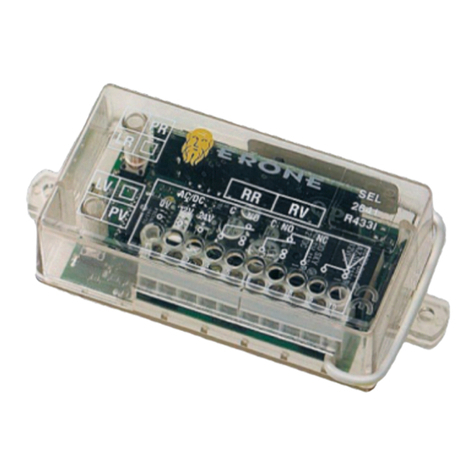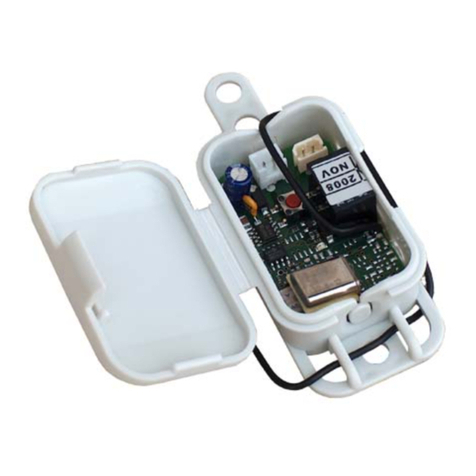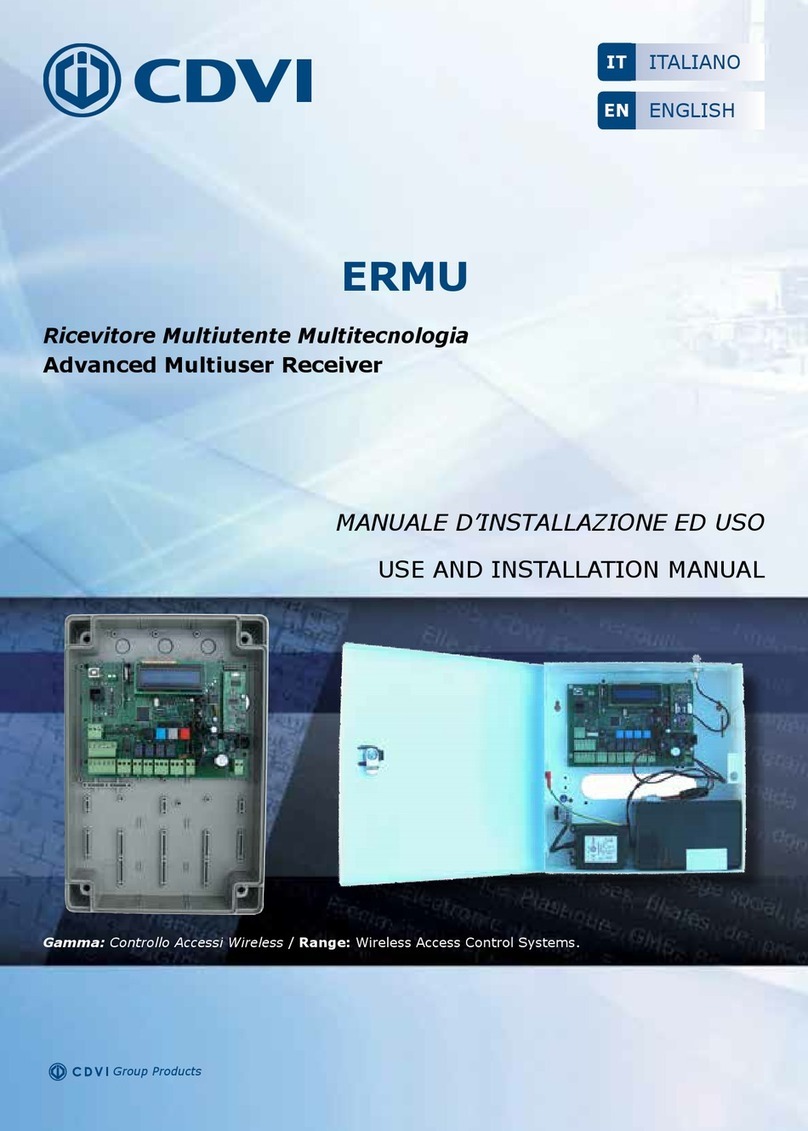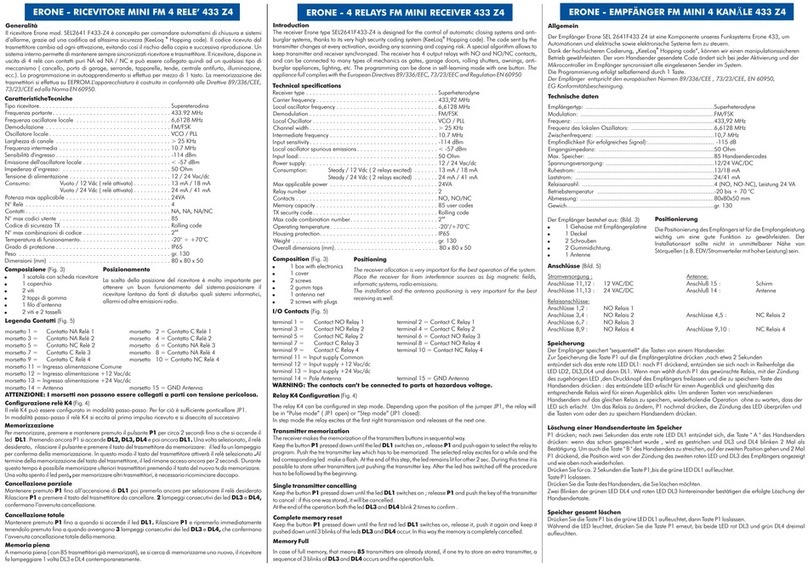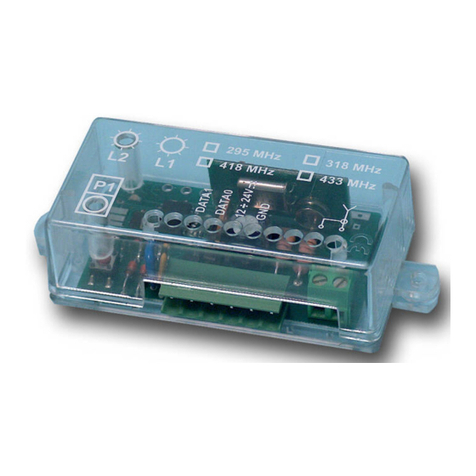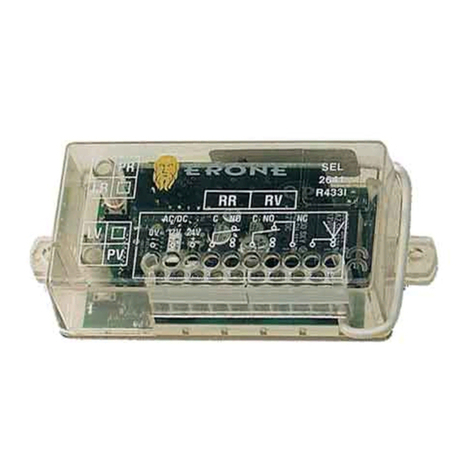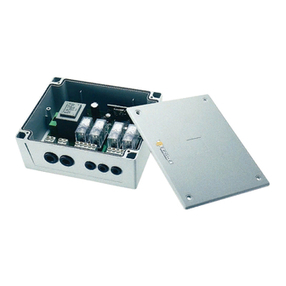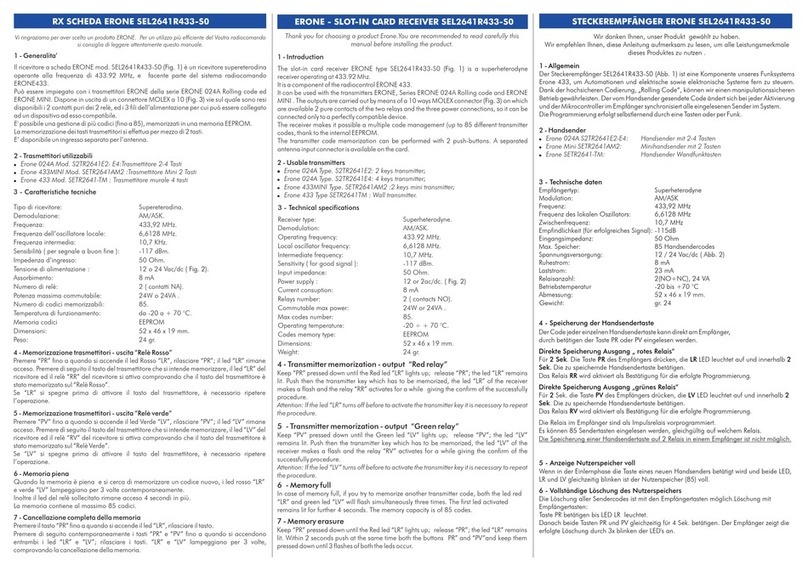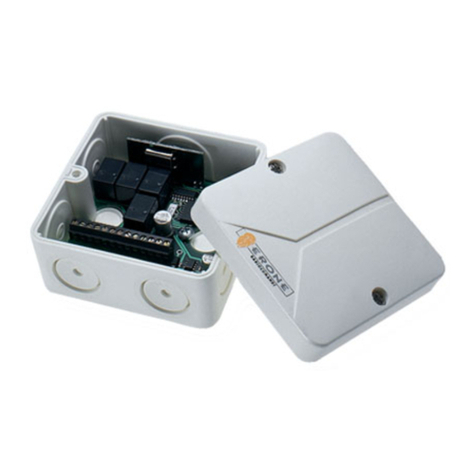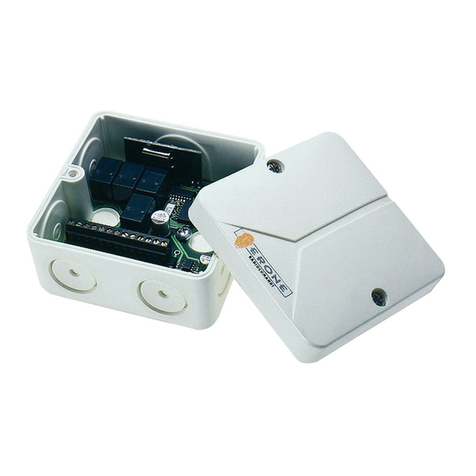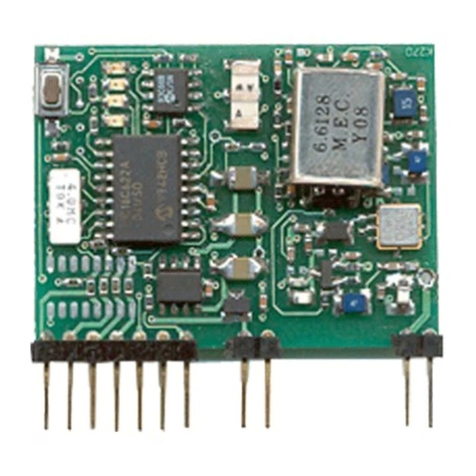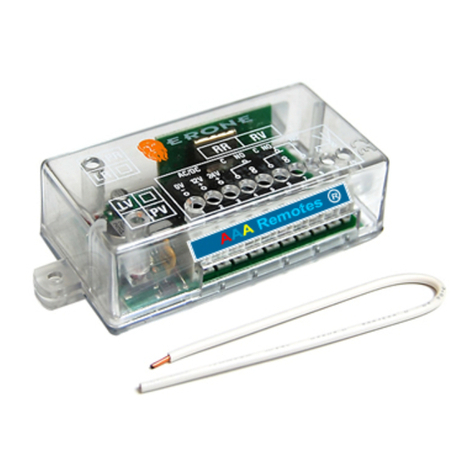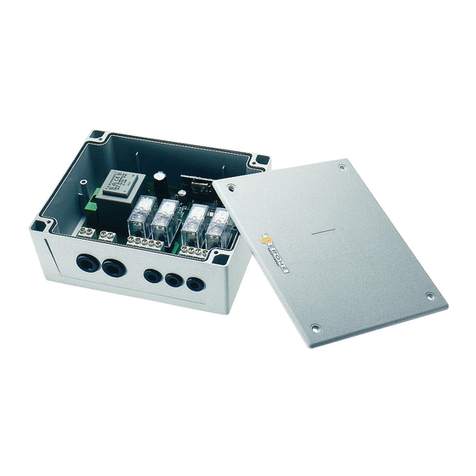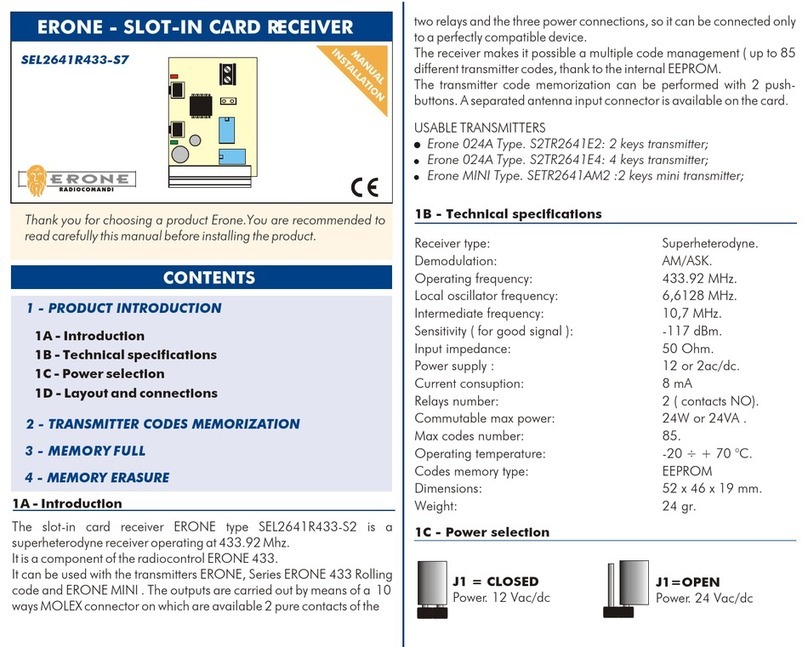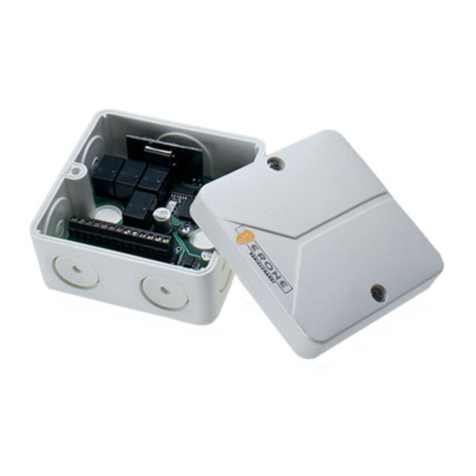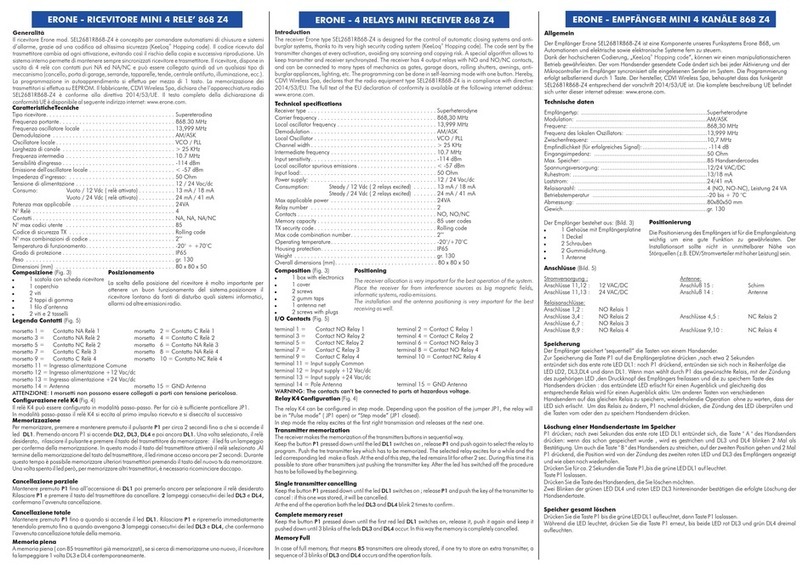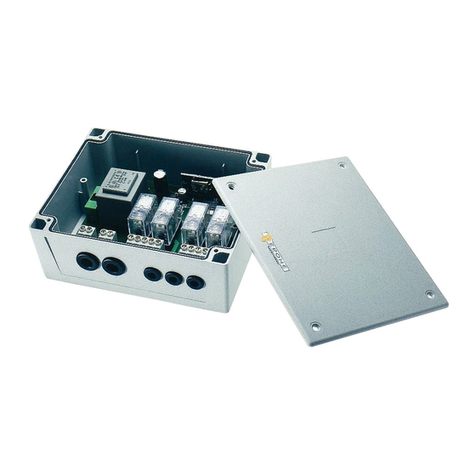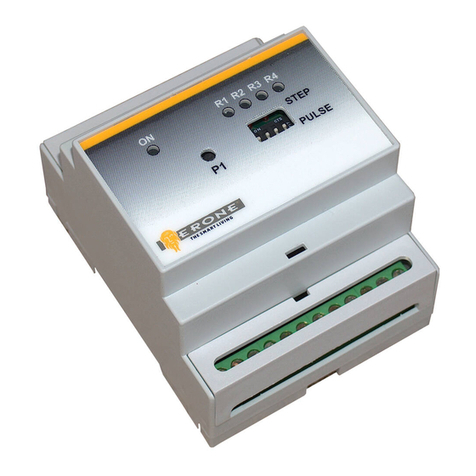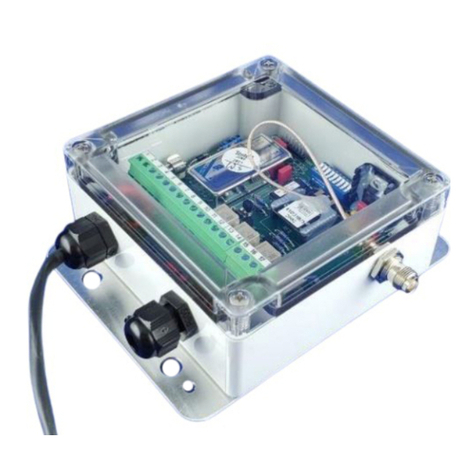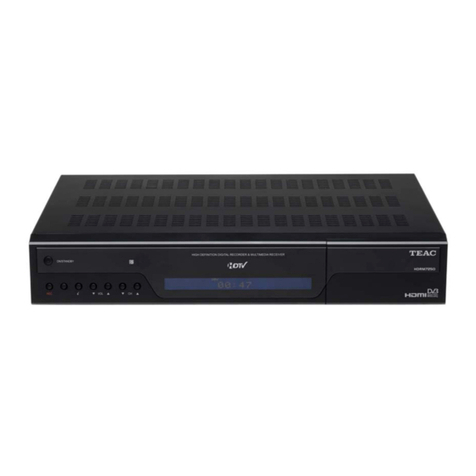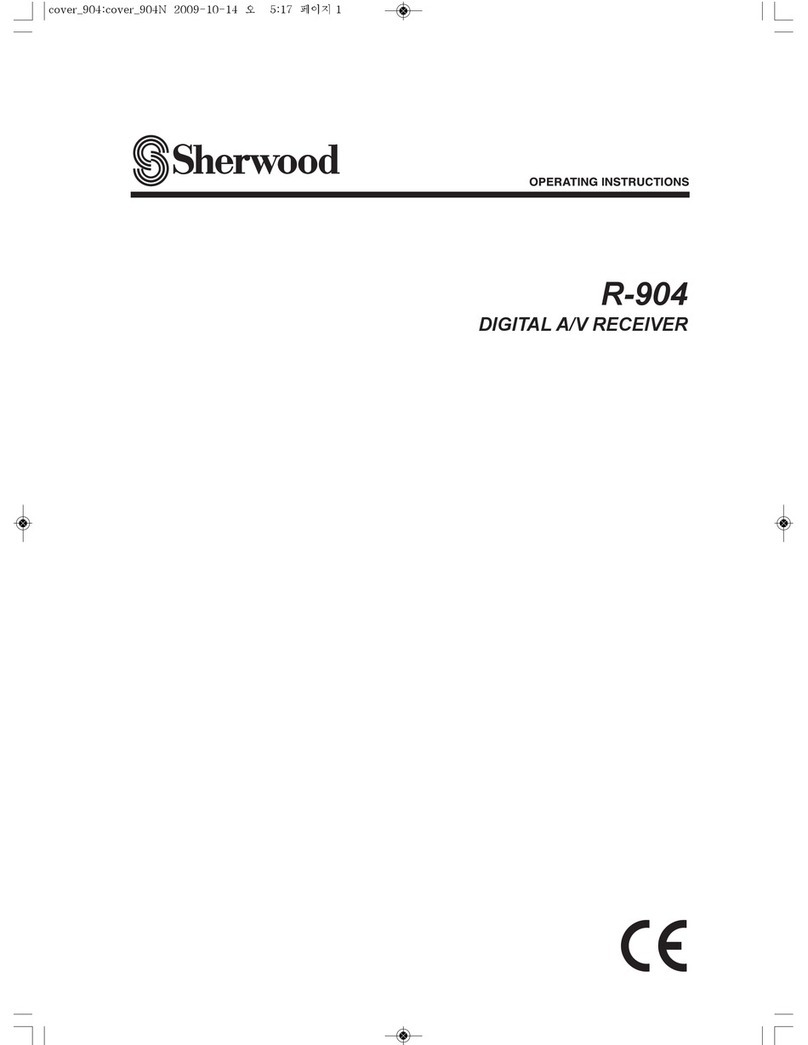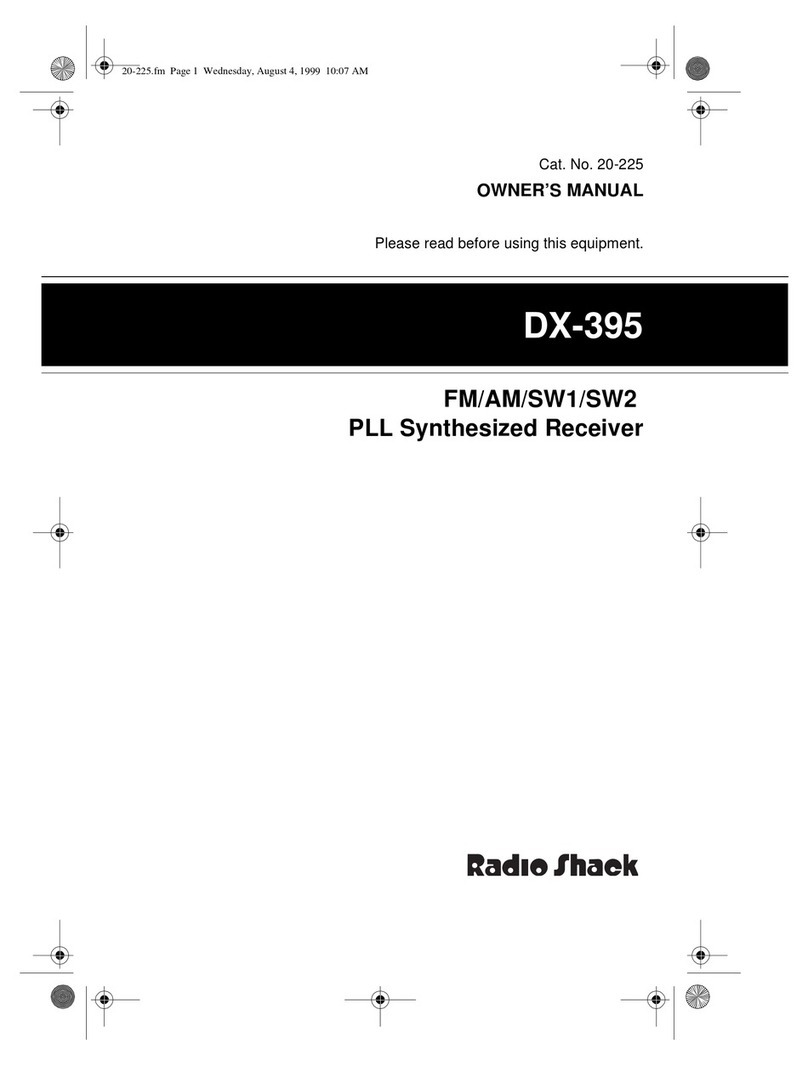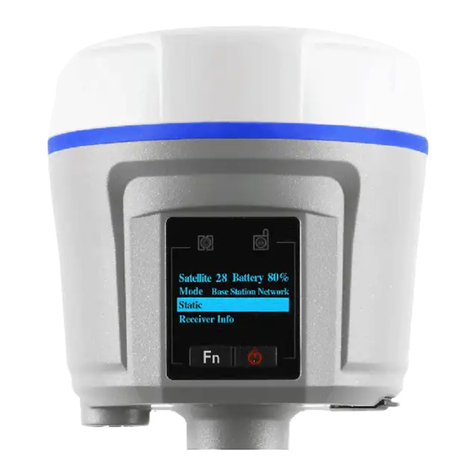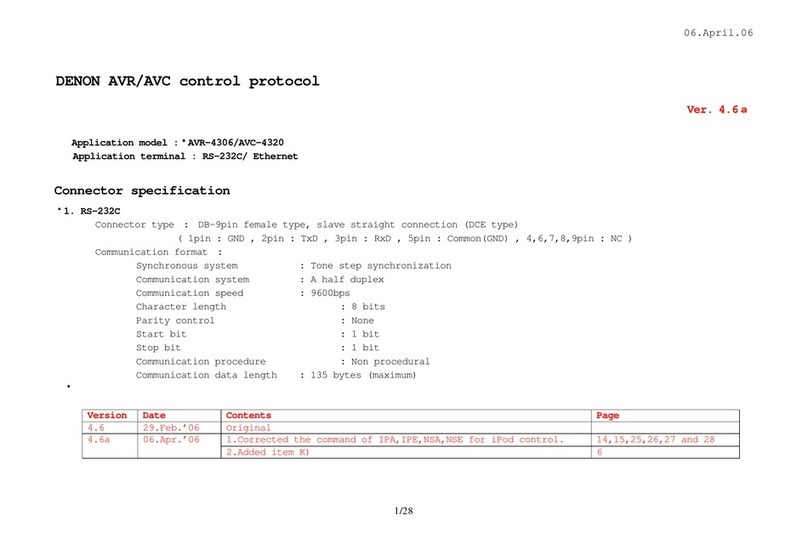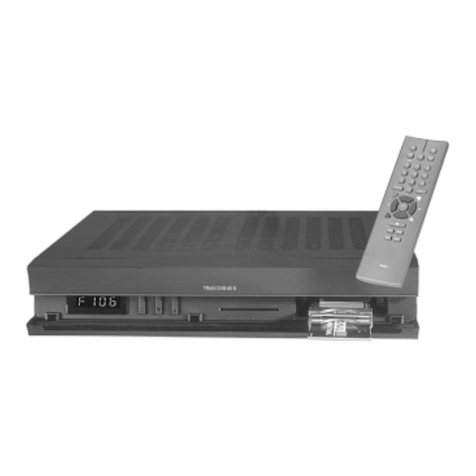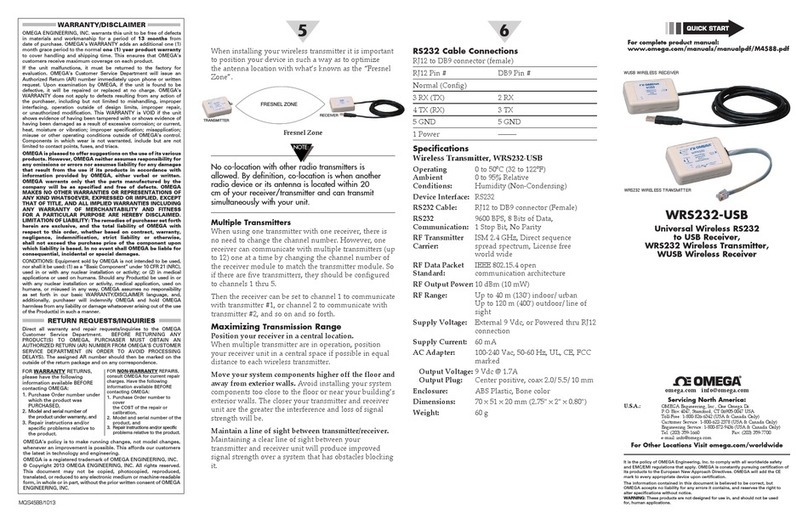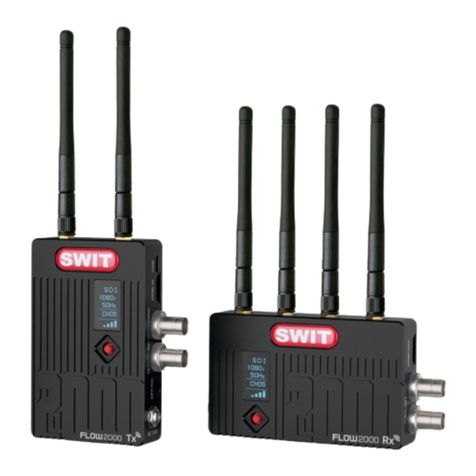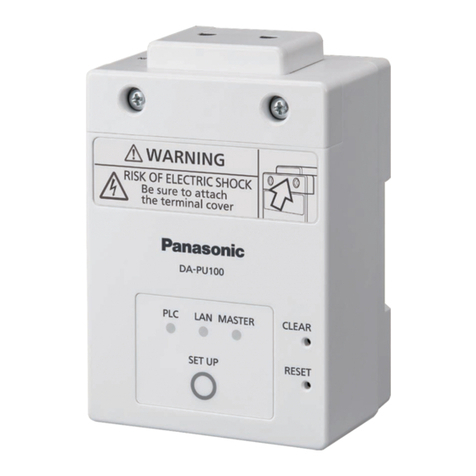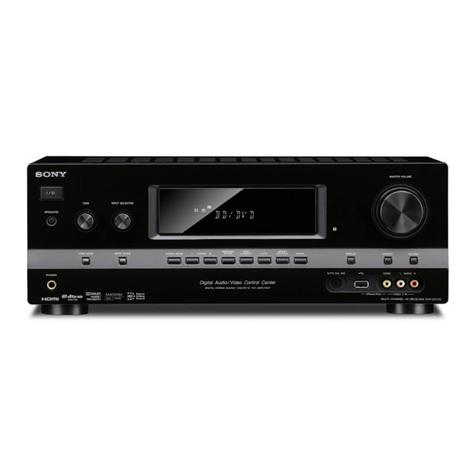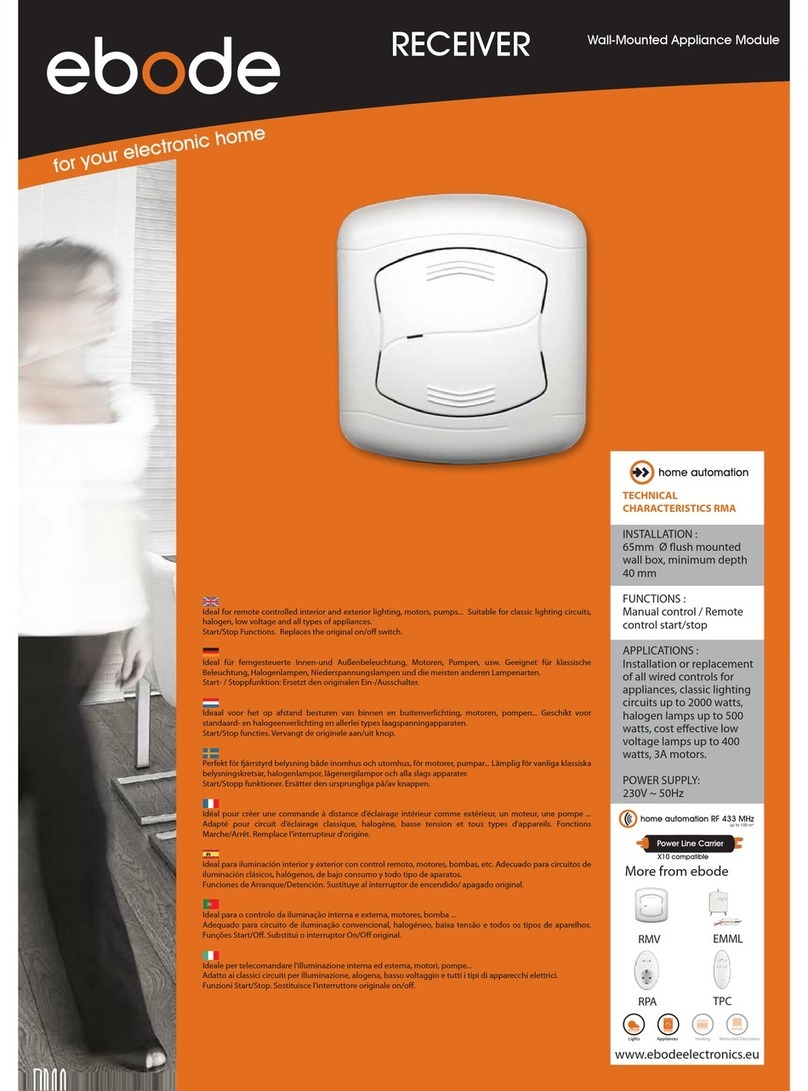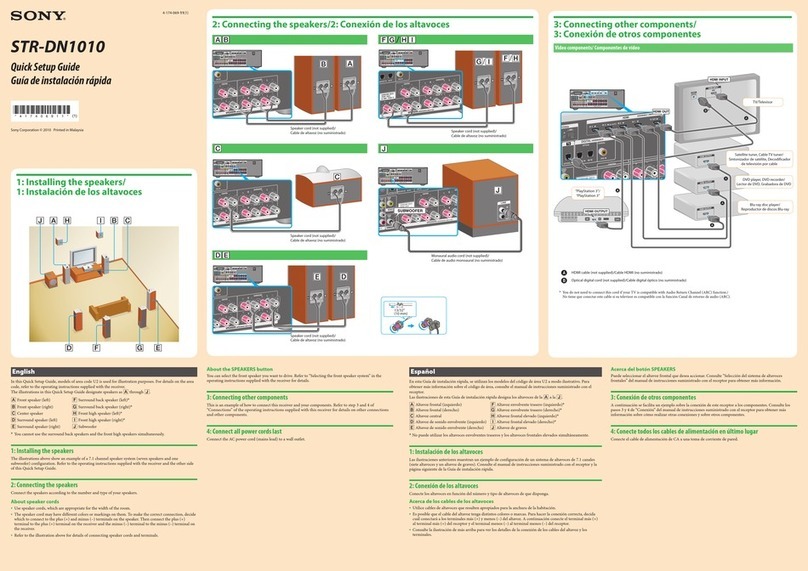
EMPFÄNGER MINI 2 433 Z2KANÄLE
Allgemein
Der Empfänger SEL 2641 R433 Z2 ist eine Komponente unseres Funksystems 433, um Automationen
und elektrische sowie elektronische Systeme fern zu steuern.
Dank der hochsicheren Codierung, „ “, können wir einen
manipulationssicheren Betrieb gewährleisten. Der vom Handsender gesendete Code ändert sich bei
jeder Aktivierung und der Mikrocontroller im Empfänger syncronisiert alle eingelesenen Sender im
System.Die Programmierung erfolgt selbstlernend durch 1 Taste.
Der Empfänger entspricht den europäischen Normen 89/336/CEE , 73/23/CEE, EN 60950,
EG Konformitätsbescheinigung.
®
KeeLoq Hopping code
Technische daten
Empfängertyp: ............................................................................Superheterodyne
Modulation: ...............................................................................AM/ASK
Frequenz: ...................................................................................433,92 MHz
Frequenz des lokalen Oszillators: .................................................6,6128 MHz
Zwischenfrequenz: ......................................................................10,7 MHz
Empfindlichkeit (für erfolgreiches Signal):....................................... -115 dB
Eingangsimpedanz: ....................................................................50 Ohm
Max. Speicher: ...........................................................................85 Handsendercodes
Spannungsversorgung: ................................................................12/24 VAC/DC
Ruhestrom: .................................................................................13/18 mA
Laststrom: ..................................................................................24/41 mA
Relaisanzahl: ..............................................................................2 (NO, NO-NC), Leistung 24 VA
Betriebstemperatur .....................................................................-20 bis + 70 °C
Abmessung: ...............................................................................80x80x50 mm
Gewich.......................................................................................gr. 130
Positionierung
Die Positionierung des Empfängers ist für die
Empfangsleistung wichtig um eine gute Funktion zu
gewährleisten. Der Installationsort sollte nicht in
unmittelbarer Nähe von Störquellen ( z.B. EDV/Stromverteiler
mit hoher Leistung) sein.
Der Empfänger bestehet aus: (Bild. 3)
!1 Gehaüse mit platine
!1 Deckel
!2 Schrauben
!2 Gummidichtung.
!1 Antenne
Empfänger
Montagen
Empfängerdeckel entfernen.
Das Gehäuse mit Schrauben befestingen. Am Ende die Gummidichtung befestigen.
Anschlüsse (Bild. 5)
Stromversorgung : Antenne:
Anschlüsse 11,12 : 12 VAC/DC Anschluß 15 : Schirm
Anschlüsse 11,13 : 24 VAC/DC Anschluß 14 : Antenne
Relaisanschlüsse:
Anschlüsse 8,9 : NO Relais Anschlüsse 9,10 : NC Relais
Einstellung des Relais K4 (Bild. 4)
Das Relais K4 Kann durch den Jumper JP1 als on /off oder impuls eingestellt werden
Speicherung
Der Empfänger speichert "sequentiell“ die Tasten von einem Handsender.
Zur Speicherung die Taste P1 auf die Empfängerplatine drücken ,nach etwa 2 Sekunden
entzündet sich das erste rote LED DL3: noch P1 drückend, entzünden sie sich noch in Reihenfolge die
LED DL3,DL4 und dann DL3. Wenn man wählt durch P1 das gewünschte Relais, mit der Zündung des
zugehörigen LED ,den Druckknopf des Empfängers freilassen und die zu speichern Taste des
Handsenders drücken : das entzündete LED erlischt für einen Augenblick und gleichzeitig das
entsprechende Relais wird für einen Augenblick aktiv. Um anderen Tasten von verschiedenen
Handsendern auf das gleichen Relais zu speichern, wiederholendie Operation ohne zu warten, dass
der LED sich erlischt. Um das Relais zu ändern, P1 nochmal drücken, die Zündung des LED
überprüfen und die Tasten vom oder den zu speichern Handsendern drücken.
Löschung einer Handsendertaste im Speicher
P1 drücken; nach zwei Sekunden das erste rote LED DL3 entzündet sich, die Taste " A " des Handsenders
drücken: wenn das schon gespeichert wurde , wird es gestrichen und DL3 und DL4 blinken 2 Mal als
Bestätigung. Um auch die Taste " B " des Handsenders zu streichen, auf der zweiten Position gehen und 2
Mal P1 drückend, die Position wird von der Zündung des zweiten roten LED und DL3 des Empfängers
angezeigt und wie oben noch wiederholen.
Drücken Sie für ca. 2 Sekunden die Taste P1,bis die grüne LED DL3 auf leuchtet.
Taste P1 loslassen.Drücken Sie die Taste des Handsenders, die Sie löschen möchten. Zwei Blinken der
grünen LED DL4 und roten LED DL3 hintereinander bestätigen die erfolgte Löschung der
Handsendertaste.
Speicher gesamt löschen
Drücken Sie die Taste P1 bis die grüne LED DL3 aufleuchtet, dann Taste P1 loslassen. Während die LED
leuchtet, drücken Sie die Taste P1 erneut, bis beide LED rot DL3 und grün DL4 dreimal aufleuchten.
Damit haben Sie den gesamten Speicher gelöscht.
2 RELAYS MINI RECEIVER 433 Z2
RICEVITORE MINI 2 RELE’ 433 Z2
Introduction
The receiver mod. SEL2641 R433-Z2 is designed for the control of automatic closing systems and anti-
®
burglar systems, thanks to its very high security coding system (KeeLoq Hopping code). The code sent by the
transmitter changes at every activation, avoiding any scanning and copying risk. A special algorithm allows
to keep transmitter and receiver synchronyzed. The receiver has 2 output relays with NO and NO/NC
contacts, and can be connected to many types of mechanics as gates, garage doors, rolling shutters,
awnings, anti-burglar appliances, lighting, etc. The programming can be done in self-learning mode with
one button. The appliance full complies with the European Directives 89/336/EEC, 73/23/EEC and
Regulation EN 60950
Technical specifications
Receiver type . . . . . . . . . . . . . . . . . . . . . . . . . . . . . . . . . . . . . . . Superheterodyne
Carrier frequency . . . . . . . . . . . . . . . . . . . . . . . . . . . . . . . . . . . . 433,92 MHz
Local oscillator frequency . . . . . . . . . . . . . . . . . . . . . . . . . . . . . . 6.6128 MHz
Demodulation . . . . . . . . . . . . . . . . . . . . . . . . . . . . . . . . . . . . . . AM/ASK
Local Oscillator . . . . . . . . . . . . . . . . . . . . . . . . . . . . . . . . . . . . . VCO / PLL
Channel width . . . . . . . . . . . . . . . . . . . . . . . . . . . . . . . . . . . . . . > 25 KHz
Intermediate frequency . . . . . . . . . . . . . . . . . . . . . . . . . . . . . . . . 10.7 MHz
Input sensitivity . . . . . . . . . . . . . . . . . . . . . . . . . . . . . . . . . . . . . . -115 dBm
Local oscillator spurious emissions . . . . . . . . . . . . . . . . . . . . . . . . < -57 dBm
Input load:. . . . . . . . . . . . . . . . . . . . . . . . . . . . . . . . . . . . . . . . . 50 Ohm
Power supply: . . . . . . . . . . . . . . . . . . . . . . . . . . . . . . . . . . . . . . 12 / 24 Vac/dc
Consumption: Steady / 12 Vdc ( 2 relays excited) . . . . . . . 13 mA / 18 mA
Steady / 24 Vdc ( 2 relays excited) . . . . . . . 24 mA / 41 mA
Max applicable power . . . . . . . . . . . . . . . . . . . . . . . . . . . . . . . . 24VA
Relay number . . . . . . . . . . . . . . . . . . . . . . . . . . . . . . . . . . . . . . 2
Contacts . . . . . . . . . . . . . . . . . . . . . . . . . . . . . . . . . . . . . . . . . . NO, NO/NC
Memory capacity . . . . . . . . . . . . . . . . . . . . . . . . . . . . . . . . . . . . 85 user codes
TX security code . . . . . . . . . . . . . . . . . . . . . . . . . . . . . . . . . . . . . Rolling code
64
Max code combination number. . . . . . . . . . . . . . . . . . . . . . . . . . 2
Operating temperature. . . . . . . . . . . . . . . . . . . . . . . . . . . . . . . . -20°/+70°C
Housing protection. . . . . . . . . . . . . . . . . . . . . . . . . . . . . . . . . . . IP65
Weight . . . . . . . . . . . . . . . . . . . . . . . . . . . . . . . . . . . . . . . . . . . gr. 130
Overall dimensions (mm). . . . . . . . . . . . . . . . . . . . . . . . . . . . . . . 80 x 80 x 50
Positioning
The receiver allocation is very important for the best operation of the
system. Place the receiver far from interference sources as big
magnetic fields, informatic systems, radio emissions.
The installation and the antenna positioning is very important for the
best receiving as well.
Composition (Fig. 3)
!1 box with electronics
!1 cover
!2 screws
!2 gumm taps
!1 antenna net
!2 screws with plugs
I/O Contacts - (Fig. 5)
terminal 6 = Contact NO Relay 3 terminal 7 = Contact C Relay 3
terminal 8 = Contact NO Relay 4 terminal 11 = Input supply Common
terminal 9 = Contact C Relay4 terminal 12 = Input supply +12 Vac/dc
terminal 10 = Contact NO Relay4 terminal 13 = Input supply +24 Vac/dc
terminal 14 = Pole Antenna terminal 15 = GND Antenna
WARNING: The contacts can’t be connected to parts at hazardous voltage.
Fixing
Remove the receiver cover. Fix the box by using the screws and the plugs supplied;
At the end place the taps supplied over the holes to protect the screws head.
Transmitter memorization
The receiver makes the memorization of the transmitters buttons in sequential way.
Keep the button P1 pressed down until the led DL3 switches on , release P1 and push again to select the
relay to program. Push the tre transmitter key which has to be memorized. The selected relay excites for a
while and the led corresponding led make a flash. At the end of this step, the led remains lit for other 2 sec.
During this time it is possible to store other transmitters just pushing the transmitter key. After the led has
switched off the procedure has to be followed by the beginning.
Relay K4 Configuration (Fig. 4)
The relay K4 can be configured in step mode. Depending upon the position of the jumper JP1, the relay
will be in “Pulse mode” ( JP1 open) or “Step mode” (JP1 closed).
In step mode the relay excites at the first right transmission and releases at the next one.
Single transmitter cancelling
Keep the button P1 pressed down until the led DL3 switches on ; release P1 and push the key of the
transmitter to cancel : if this one was stored, it will be cancelled: at the end of the operation both the led DL3
and DL4 blink 2 times to confirm .
Complete memory reset
Keep the button P1 pressed down until the first red led DL3 switches on, release it, push it again and keep it
pushed down until 3 blinks of the leds DL3 and DL4 occur. In this way the memory is completely cancelled.
Memory Full
In case of full memory, that means 85 transmitters are already stored, if one try to store an extra transmitter, a
sequence of 3 blinks of DL3 and DL4 occurs and the operation fails.
Generalità
Il ricevitore mod. SEL2641 R433-Z2 è concepito per comandare automatismi di chiusura e sistemi d’allarme,
®
grazie ad una codifica ad altissima sicurezza (KeeLoq Hopping code). Il codice ricevuto dal trasmettitore cambia
ad ogni attivazione, evitando così il rischio della copia e successiva riproduzione. Un sistema interno permette di
mantenere sempre sincronizzati ricevitore e trasmettitore. Il ricevitore, dispone in uscita di 2 relè con contatti puri
NA ed NA / NC e può essere collegato quindi ad un qualsiasi tipo di meccanismo ( cancello, porta di garage,
serrande, tapparelle, tende, centrale antifurto, illuminazione, ecc.). La programmazione in autoapprendimento si
effettua per mezzo di 1 tasto. La memorizzazione dei trasmettitori si effettua su EEPROM.
L’apparecchiatura è costruita in conformità alle Direttive 89/336/CEE, 73/23/CEE ed alla Norma EN 60950.
CaratteristicheTecniche
Tipo ricevitore. . . . . . . . . . . . . . . . . . . . . . . . . . . . . . . . . . . . . . . Supereterodina
Frequenza portante . . . . . . . . . . . . . . . . . . . . . . . . . . . . . . . . . . . 433.92 MHz
Frequenza oscillatore locale . . . . . . . . . . . . . . . . . . . . . . . . . . . . 6.6128 MHz
Demodulazione . . . . . . . . . . . . . . . . . . . . . . . . . . . . . . . . . . . . . AM/ASK
Oscillatore locale . . . . . . . . . . . . . . . . . . . . . . . . . . . . . . . . . . . . VCO / PLL
Larghezza di canale . . . . . . . . . . . . . . . . . . . . . . . . . . . . . . . . . . > 25 KHz
Frequenza intermedia . . . . . . . . . . . . . . . . . . . . . . . . . . . . . . . . . 10.7 MHz
Sensibilità d'ingresso . . . . . . . . . . . . . . . . . . . . . . . . . . . . . . . . . . -115 dBm
Emissione dell'oscillatore locale . . . . . . . . . . . . . . . . . . . . . . . . . . < -57 dBm
Impedenza d’ingresso: . . . . . . . . . . . . . . . . . . . . . . . . . . . . . . . . 50 Ohm
Tensione di alimentazione . . . . . . . . . . . . . . . . . . . . . . . . . . . . . . 12 / 24 Vac/dc
Consumo: Vuoto / 12 Vdc ( relè attivato) . . . . . . . . . . . 13 mA / 18 mA
Vuoto / 24 Vdc ( relè attivato) . . . . . . . . . . . 24 mA / 41 mA
Potenza max applicabile . . . . . . . . . . . . . . . . . . . . . . . . . . . . . . . 24VA
N° Relè . . . . . . . . . . . . . . . . . . . . . . . . . . . . . . . . . . . . . . . . . . . 2
Contatti . . . . . . . . . . . . . . . . . . . . . . . . . . . . . . . . . . . . . . . . . . . NA, NA, NA/NC
N° max codici utente . . . . . . . . . . . . . . . . . . . . . . . . . . . . . . . . . 85
Codice di sicurezza TX . . . . . . . . . . . . . . . . . . . . . . . . . . . . . . . . Rolling code
64
N° max combinazioni di codice . . . . . . . . . . . . . . . . . . . . . . . . . . 2
Temperatura di funzionamento. . . . . . . . . . . . . . . . . . . . . . . . . . . -20° ÷ +70°C
Grado di protezione . . . . . . . . . . . . . . . . . . . . . . . . . . . . . . . . . . IP65
Peso . . . . . . . . . . . . . . . . . . . . . . . . . . . . . . . . . . . . . . . . . . . . . gr. 130
Dimensioni (mm) . . . . . . . . . . . . . . . . . . . . . . . . . . . . . . . . . . . . 80 x 80 x 50
Posizionamento
La scelta della posizione del ricevitore è molto importante per
ottenere un buon funzionamento del sistema.posizionare il ricevitore
lontano da fonti di disturbo quali sistemi informatici, allarmi od altre
emissioni radio.
Composizione (Fig. 3)
!1 scatola con scheda ricevitore
!1 coperchio
!2 viti
!2 tappi di gomma
!1 filo d’antenna
!2 viti e 2 tasselli
Legenda Contatti (Fig. 5)
morsetto 6 = Contatto NA Relè 3 morsetto 7 = Contatto C Relè 3
morsetto 8 = Contatto NA Relè 4 morsetto 11 = Ingresso alimentazione Comune
morsetto 9 = Contatto C Relè 4 morsetto 12 = Ingresso alimentazione +12 Vac/dc
morsetto 10 = Contatto NC Relè 4 morsetto 13 = Ingresso alimentazione +24 Vac/dc
morsetto 14 = Antenna morsetto 15 = GND Antenna
ATTENZIONE: I morsetti non possono essere collegati a parti con tensione pericolosa.
Memorizzazione
Per memorizzare, premere e mantenere premuto il pulsante P1 per circa 2 secondi fino a che si accende il led
DL3. Premendo ancora P1 si accende DL4 e poi ancora DL3. Una volta selezionato, il relè desiderato, rilasciare
il pulsante e premere il tasto del trasmettitore da memorizzare: il led fa un lampeggio per conferma della
memorizzazione. In questo modo il tasto del trasmettitore provocherà l’attivazione del relè selezionato . Al termine
della memorizzazione del tasto del trasmettitore, il led rimane acceso ancora per 2 secondi. Durante questo
tempo è possibile memorizzare ulteriori trasmettitori premendo il tasto del nuovo tx da memorizzare. Una volta
spento il led però,per memorizzare altri trasmettitori, è necessario ricominciare daccapo.
Fissaggio
Togliere il coperchio dal ricevitore. Fissare la scatola utilizzando viti e tasselli appropriati alla natura del
supporto. Al termine mettere i tappi di gomma in dotazione a protezione delle viti di fissaggio.
Configurazione relè K4 (Fig. 4)
Il relè K4 può essere configurato in modalità passo-passo. Per far ciò è sufficiente ponticellare JP1.
In modalità passo-passo il relè K4 si eccita al primo impulso ricevuto e si diseccita al successivo
Cancellazione parziale
Mantenere premuto P1 fino all’accensione di DL3 poi premerlo ancora per selezionare il relè desiderato
Rilasciare P1 e premere il tasto del trasmettitore da cancellare. 2lampeggi consecutivi dei led DL4 e DL3,
confermano l’avvenuta cancellazione.
Cancellazione totale
Mantenere premuto P1 fino a quando si accende il led DL3. Rilasciare P1 e ripremerlo immediatamente
tenendolo premuto fino a quando avvengono 3lampeggi consecutivi dei led DL4 e DL3, che confermano
l’avvenuta cancellazione totale della memoria.
Memoria piena
A memoria piena ( con 85 trasmettitori già memorizzati), se si cerca di memorizzarne uno nuovo, il ricevitore fa
lampeggiare 1 volta DL3 e DL4 contemporaneamente.


